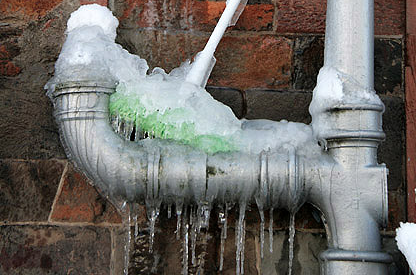Tips to Avoid Frozen Plumbing in Cold Weather: Expert Tips
Tips to Avoid Frozen Plumbing in Cold Weather: Expert Tips
Blog Article
Presented here below you can find more amazing additional info concerning 6 Ways to Prevent Frozen Pipes.

Cold weather can damage your pipes, specifically by freezing pipelines. Below's just how to avoid it from taking place and what to do if it does.
Introduction
As temperature levels decrease, the threat of icy pipes boosts, potentially bring about pricey repair services and water damages. Comprehending how to prevent frozen pipes is critical for home owners in chilly climates.
Understanding Frozen Pipes
What creates pipes to ice up?
Pipes ice up when exposed to temperature levels listed below 32 ° F (0 ° C) for prolonged periods. As water inside the pipelines freezes, it increases, putting pressure on the pipeline walls and possibly triggering them to rupture.
Dangers and damages
Icy pipes can cause supply of water disturbances, building damage, and costly repair work. Ruptured pipes can flood homes and create considerable architectural damage.
Signs of Frozen Pipeline
Recognizing frozen pipes early can stop them from bursting.
Just how to determine frozen pipelines
Search for decreased water flow from faucets, unusual odors or sounds from pipelines, and noticeable frost on subjected pipes.
Avoidance Tips
Protecting susceptible pipelines
Wrap pipes in insulation sleeves or make use of heat tape to shield them from freezing temperatures. Focus on pipelines in unheated or exterior areas of the home.
Home heating methods
Keep indoor spaces properly heated, specifically locations with plumbing. Open up closet doors to enable warm air to circulate around pipelines under sinks.
Safeguarding Outside Pipes
Yard hose pipes and exterior taps
Disconnect and drain pipes yard tubes prior to winter. Mount frost-proof spigots or cover outside taps with protected caps.
What to Do If Your Pipelines Freeze
Immediate actions to take
If you think frozen pipelines, keep taps open up to eliminate stress as the ice melts. Make use of a hairdryer or towels taken in hot water to thaw pipes slowly.
Long-Term Solutions
Structural modifications
Think about rerouting pipes away from outside walls or unheated areas. Include additional insulation to attic rooms, cellars, and crawl spaces.
Updating insulation
Purchase top notch insulation for pipelines, attic rooms, and wall surfaces. Appropriate insulation helps preserve regular temperatures and decreases the danger of icy pipes.
Conclusion
Stopping icy pipelines requires positive procedures and fast feedbacks. By comprehending the reasons, indicators, and safety nets, home owners can safeguard their plumbing during cold weather.
6 Proven Ways to Prevent Frozen Pipes and Protect Your Home
Disconnect and Drain Garden Hoses
Before winter arrives, start by disconnecting your garden hoses and draining any remaining water. Close the shut-off valves that supply outdoor hose bibs and leave the outdoor faucet open to allow any residual water to drain. For extra protection, consider using faucet covers throughout the colder months. It’s also important to drain water from any sprinkler supply lines following the manufacturer’s directions.
Insulate Exposed Pipes
Insulating your pipes is an effective way to prevent freezing. Pipe insulation is readily available at home improvement stores and is relatively inexpensive. Pay close attention to pipes in unheated areas such as the attic, basement, crawl spaces, or garage. Apply foam insulation generously to create a buffer against the cold. You can also wrap your pipes in heat tape or thermostat-controlled heat cables for added warmth.
Seal Air Leaks
Inspect your home for any cracks or openings that could let in cold air. Seal any holes around the piping in interior or exterior walls, as well as the sill plates where your home rests on its foundation. Additionally, make sure to keep your garage door closed unless you’re entering or exiting. Leaving it open creates a significant air leak that can lead to frozen pipes.
Allow Warm Air Circulation
During cold snaps, it’s essential to allow warm air to circulate evenly throughout your home. Leave interior doors ajar to promote better airflow. Open kitchen and bathroom cabinets to help distribute heat consistently around the rooms. If you have small children or pets, be sure to remove any household chemicals or potentially harmful cleaners from open cabinets for safety.
Let Faucets Drip
A small trickle of water can make a big difference in preventing ice formation inside your pipes. When temperatures drop significantly, start a drip of water from all faucets served by exposed pipes. This continuous flow helps prevent the water from freezing. Additionally, running a few faucets slightly can relieve pressure inside the pipes, reducing the chances of a rupture if the water inside does freeze.
https://choateshvac.com/6-proven-ways-to-prevent-frozen-pipes-and-protect-your-home/

I'm very serious about Helpful Tips to Prevent Frozen Pipes this Winter and I'm hoping you appreciated the new piece. Sharing is nice. Helping people is fun. Thanks a lot for being here. Return soon.
Suggested Site Report this page